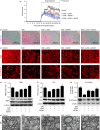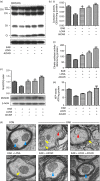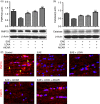Combination therapy of lovastatin and AMP-activated protein kinase activator improves mitochondrial and peroxisomal functions and clinical disease in experimental autoimmune encephalomyelitis model
- PMID: 29331024
- PMCID: PMC6002225
- DOI: 10.1111/imm.12893
Combination therapy of lovastatin and AMP-activated protein kinase activator improves mitochondrial and peroxisomal functions and clinical disease in experimental autoimmune encephalomyelitis model
Abstract
Recent studies report that loss and dysfunction of mitochondria and peroxisomes contribute to the myelin and axonal damage in multiple sclerosis (MS). In this study, we investigated the efficacy of a combination of lovastatin and AMP-activated protein kinase (AMPK) activator (AICAR) on the loss and dysfunction of mitochondria and peroxisomes and myelin and axonal damage in spinal cords, relative to the clinical disease symptoms, using a mouse model of experimental autoimmune encephalomyelitis (EAE, a model for MS). We observed that lovastatin and AICAR treatments individually provided partial protection of mitochondria/peroxisomes and myelin/axons, and therefore partial attenuation of clinical disease in EAE mice. However, treatment of EAE mice with the lovastatin and AICAR combination provided greater protection of mitochondria/peroxisomes and myelin/axons, and greater improvement in clinical disease compared with individual drug treatments. In spinal cords of EAE mice, lovastatin-mediated inhibition of RhoA and AICAR-mediated activation of AMPK cooperatively enhanced the expression of the transcription factors and regulators (e.g. PPARα/β, SIRT-1, NRF-1, and TFAM) required for biogenesis and the functions of mitochondria (e.g. OXPHOS, MnSOD) and peroxisomes (e.g. PMP70 and catalase). In summary, these studies document that oral medication with a combination of lovastatin and AICAR, which are individually known to have immunomodulatory effects, provides potent protection and repair of inflammation-induced loss and dysfunction of mitochondria and peroxisomes as well as myelin and axonal abnormalities in EAE. As statins are known to provide protection in progressive MS (Phase II study), these studies support that supplementation statin treatment with an AMPK activator may provide greater efficacy against MS.
Keywords: autoimmunity; experimental autoimmune encephalomyelitis/multiple sclerosis; neurodegeneration; neuroinflammation.
© 2018 John Wiley & Sons Ltd.
Figures









Similar articles
-
Immunomodulatory effect of combination therapy with lovastatin and 5-aminoimidazole-4-carboxamide-1-beta-D-ribofuranoside alleviates neurodegeneration in experimental autoimmune encephalomyelitis.Am J Pathol. 2006 Sep;169(3):1012-25. doi: 10.2353/ajpath.2006.051309. Am J Pathol. 2006. PMID: 16936274 Free PMC article.
-
5-aminoimidazole-4-carboxamide ribonucleoside: a novel immunomodulator with therapeutic efficacy in experimental autoimmune encephalomyelitis.J Immunol. 2005 Jul 1;175(1):566-74. doi: 10.4049/jimmunol.175.1.566. J Immunol. 2005. PMID: 15972693
-
5-aminoimidazole-4-carboxamide-1-beta-4-ribofuranoside attenuates experimental autoimmune encephalomyelitis via modulation of endothelial-monocyte interaction.J Neurosci Res. 2006 Aug 15;84(3):614-25. doi: 10.1002/jnr.20953. J Neurosci Res. 2006. PMID: 16770773
-
Turn up the power - pharmacological activation of mitochondrial biogenesis in mouse models.Br J Pharmacol. 2014 Apr;171(8):1818-36. doi: 10.1111/bph.12413. Br J Pharmacol. 2014. PMID: 24102298 Free PMC article. Review.
-
Neurosteroidogenesis and progesterone anti-inflammatory/neuroprotective effects.J Neuroendocrinol. 2018 Feb;30(2). doi: 10.1111/jne.12502. J Neuroendocrinol. 2018. PMID: 28675779 Review.
Cited by
-
The complexities of investigating mitochondria dynamics in multiple sclerosis and mouse models of MS.Front Neurosci. 2023 Jul 25;17:1144896. doi: 10.3389/fnins.2023.1144896. eCollection 2023. Front Neurosci. 2023. PMID: 37559701 Free PMC article. Review.
-
Pharmacological Modulators of Small GTPases of Rho Family in Neurodegenerative Diseases.Front Cell Neurosci. 2021 May 12;15:661612. doi: 10.3389/fncel.2021.661612. eCollection 2021. Front Cell Neurosci. 2021. PMID: 34054432 Free PMC article.
-
Immune modulatory effects of statins.Immunology. 2018 May;154(1):69-75. doi: 10.1111/imm.12902. Epub 2018 Feb 20. Immunology. 2018. PMID: 29392731 Free PMC article. Review.
-
Metformin accelerates myelin recovery and ameliorates behavioral deficits in the animal model of multiple sclerosis via adjustment of AMPK/Nrf2/mTOR signaling and maintenance of endogenous oligodendrogenesis during brain self-repairing period.Pharmacol Rep. 2020 Jun;72(3):641-658. doi: 10.1007/s43440-019-00019-8. Epub 2019 Dec 18. Pharmacol Rep. 2020. PMID: 32048246
-
Vascular and immunopathological role of Asymmetric Dimethylarginine (ADMA) in Experimental Autoimmune Encephalomyelitis.Immunology. 2021 Nov;164(3):602-616. doi: 10.1111/imm.13396. Epub 2021 Aug 2. Immunology. 2021. PMID: 34310708 Free PMC article.
References
-
- Compston A, Coles A. Multiple sclerosis. Lancet 2002; 359:1221–31. - PubMed
-
- Michel L, Larochelle C, Prat A. Update on treatments in multiple sclerosis. Presse Med 2015; 44:e137–51. - PubMed
-
- Nikic I, Merkler D, Sorbara C, Brinkoetter M, Kreutzfeldt M, Bareyre FM et al A reversible form of axon damage in experimental autoimmune encephalomyelitis and multiple sclerosis. Nat Med 2011; 17:495–9. - PubMed
Publication types
MeSH terms
Substances
Grants and funding
LinkOut - more resources
Full Text Sources
Other Literature Sources
Molecular Biology Databases
Research Materials
Miscellaneous

